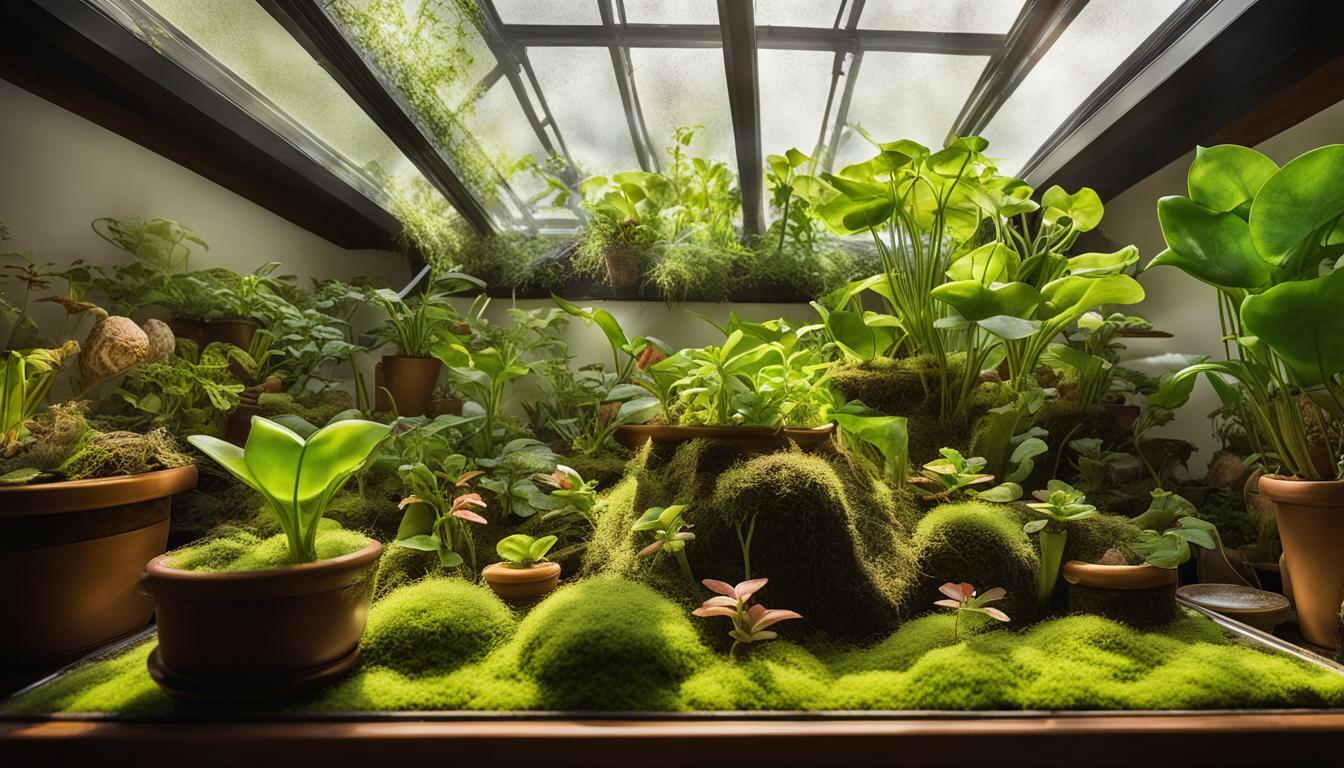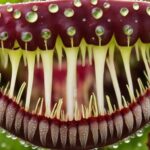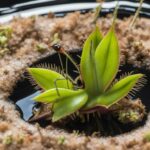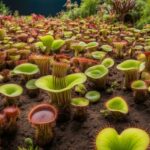If you’re a plant lover searching for a unique addition to your indoor garden, you may have wondered if Venus flytraps can be grown in terrariums. The answer is yes! These carnivorous plants can thrive in a terrarium environment, provided you meet their specific needs.
The question of whether Venus flytraps can be grown in terrariums is an important one because these plants require a unique set of conditions to survive. By learning how to care for Venus flytraps in a terrarium, you can successfully grow these fascinating plants and enjoy their carnivorous habits up close.
Key Takeaways:
- Venus flytraps can be grown in terrariums.
- Successfully growing Venus flytraps in a terrarium requires meeting their specific needs.
- Learning how to care for Venus flytraps in a terrarium can enable you to enjoy their unique carnivorous habits up close.
Understanding the Needs of Venus Flytraps
If you’re thinking of growing Venus flytraps in terrariums, it’s important to understand the specific needs of these carnivorous plants. Venus flytraps require a unique environment that mimics their natural habitat, which is typically found in the coastal plains of the southeastern United States.
One of the most critical factors in creating a suitable environment for Venus flytraps is the right type of terrarium. A terrarium for Venus flytraps should be made of clear glass or plastic and have a lid or cover to provide a humid environment. The size of the terrarium should match the number of plants you plan to grow, with adequate space for growth and airflow.
Venus flytraps also require bright, direct sunlight to survive, so it’s important to place your terrarium near a sunny window or use artificial lighting if necessary. Temperature and humidity levels should be closely monitored as well, with daytime temperatures around 70-80°F and humidity levels between 50-60%.
It’s also important to choose the right substrate for your Venus flytraps. Since they thrive in acidic soil, a mixture of peat moss and perlite is recommended. You should avoid using regular potting soil, as it contains nutrients that can be harmful to these plants.
Keep in mind that Venus flytraps require a period of dormancy during the winter months, where they will stop growing and appear to be dead. During this time, it’s important to reduce watering and provide cooler temperatures to simulate their natural environment.
Understanding the Needs of Venus Flytraps: In Summary
- Venus flytraps require a unique environment that mimics their natural habitat.
- The right type of terrarium should be clear with a lid, suitable size for the number of plants, and provide adequate airflow.
- Venus flytraps require bright, direct sunlight, ideal temperatures, and humidity levels, as well as acidic soil.
- During dormancy, it’s important to reduce watering and provide cooler temperatures.
Choosing the Right Terrarium for Venus Flytraps
When it comes to selecting the ideal terrarium for your Venus flytraps, there are a few crucial factors to consider. The type of terrarium you choose can significantly impact the plants’ growth and health, so it’s essential to make an informed decision.
Firstly, you need to decide on the size of the terrarium. Venus flytraps can grow up to six inches in diameter, so aim for a container that is at least eight inches wide and ten inches deep to allow ample room for growth.
The material of the terrarium also matters. Glass containers are a popular option as they allow for excellent visibility of the plants. However, plastic terrariums are also a viable choice, especially for those on a budget. Avoid metal containers as they can cause a temperature increase that can be harmful to Venus flytraps.
Moreover, proper ventilation is crucial for maintaining the right humidity levels inside the terrarium. Look for containers with built-in air vents or ensure the lid has gaps for air circulation.
Lastly, consider the placement of your terrarium. Venus flytraps thrive in bright, indirect sunlight, so place your terrarium near a window or under grow lights. Avoid placing the terrarium in direct sunlight as it may cause overheating and damage the plants.
Setting Up the Terrarium Environment
Now that you have chosen the right terrarium and understood the needs of Venus flytraps, it’s time to set up the perfect environment for your plants to thrive.
The first step is to prepare the substrate. Venus flytraps prefer acidic soil with good drainage. You can use a mix of peat moss and perlite or sand, but avoid using regular potting soil or fertilizers, as they can harm the plants.
Next, add water to the substrate until it’s moist but not too wet. Venus flytraps require high humidity levels, so it’s essential to maintain a moist environment without causing waterlogging. You can use a spray bottle or a humidity tray to achieve this.
The lighting is also critical. Venus flytraps need bright, indirect light to photosynthesize, but direct sunlight can cause sunburn and damage the leaves. You can place your terrarium near a west or south-facing window or use artificial grow lights for 12-14 hours a day.
When arranging your plants inside the terrarium, make sure to leave enough space for them to grow without overcrowding. You can add some decorative elements or moss, but avoid using anything that can harm the plants or change the pH of the soil.
Finally, don’t forget to provide proper ventilation. Venus flytraps require good air circulation to prevent mold or fungus growth. You can open the lid for a few minutes daily or use a small fan to keep the air flowing.
By following these steps, you can create an ideal environment for your Venus flytraps to flourish and grow healthy.
Care Tips for Venus Flytraps in Terrariums
While Venus flytraps are hardy and adaptable plants, they do require specific care to thrive in a terrarium environment. Here are some essential care tips:
- Watering: Venus flytraps need to be kept moist at all times, but not waterlogged. Water with distilled water or rainwater, and never use tap water.
- Feeding: Venus flytraps require live insects to survive. Offer them small insects such as fruit flies, crickets, or mealworms every 2-3 weeks in the growing season.
- Dormancy: Venus flytraps need a dormancy period during the winter months to rest and recharge. Reduce watering and keep the terrarium in a cooler location with less sunlight.
Despite their hardiness, Venus flytraps can still fall victim to pests and diseases. Here are some common issues and how to address them:
| Issue | Solution |
|---|---|
| Leaf browning | Too much direct sunlight or dry air. Mist the leaves regularly and move the terrarium to a shadier spot. |
| Wilting | Not enough water or too much heat. Increase watering frequency and move the terrarium to a cooler location. |
| Lack of growth | Insufficient light or poor soil quality. Provide more light and adjust the soil pH to 4.5-5.5 using sphagnum peat moss. |
With proper care, your Venus flytrap can live for several years and provide endless fascination and entertainment. If you have any further questions or concerns, consult a reputable carnivorous plant specialist or online forum.
Troubleshooting Common Issues
While growing Venus flytraps in terrariums can be a rewarding experience, it’s not uncommon for problems to arise. Here are some common issues you may encounter and ways to address them:
Browning Leaves:
If you notice your Venus flytrap’s leaves starting to turn brown, it could be due to overfeeding, underwatering, or inadequate lighting. Try reducing the amount of food you give it, watering it more regularly, and providing more direct sunlight.
Wilting:
Wilting can be caused by a lack of water or humidity, as well as excessive heat or cold. Make sure your Venus flytrap is getting enough water and mist it occasionally to boost humidity. Keep the temperature within the appropriate range (between 70°F and 80°F).
No Growth:
If your Venus flytrap isn’t growing, it could be due to inadequate light or poor soil quality. Make sure it’s getting enough direct sunlight and use a high-quality substrate that’s low in nutrients.
Remember that Venus flytraps are delicate plants and may not thrive under certain conditions. If you’re having trouble caring for your Venus flytrap, don’t hesitate to seek advice from a specialist or experienced grower.
Expanding Your Terrarium Collection
While Venus flytraps can make for stunning and fascinating additions to any terrarium, there are a plethora of other carnivorous plants that would thrive alongside them. Just like Venus flytraps, these plants are adapted to nutrient-poor environments and catch insects to supplement their diet.
One such plant is the pitcher plant, which has a unique pitcher-shaped trap that lures prey with nectar and then traps them in a slippery, downward-sloping enclosure. The sundew is another fascinating carnivorous plant that uses sticky, glandular hairs to trap small insects.
If you’re looking for a plant that’s easy to care for and hardy, the bladderwort could be a great addition. These tiny plants are aquatic and feature traps that suck in prey when triggered by tiny hairs.
When adding new plants to your terrarium, be sure to consider their specific needs in terms of humidity, lighting, and substrate. Research each plant thoroughly to ensure they’ll be happy and healthy in your terrarium environment.
Creating a diverse collection of carnivorous plants can be a rewarding and enjoyable hobby. Not only do these plants add unique beauty and intrigue to your home, but they also offer a fascinating look into the natural world and the many ways that plants have adapted to survive in harsh environments.
Conclusion
Congratulations! You have learned everything you need to know about growing Venus flytraps in terrariums. By mimicking their natural habitat in a controlled environment, you can enjoy these fascinating carnivorous plants year-round in your home.
Remember to choose the right type of terrarium, provide adequate lighting and temperature, and maintain the proper humidity levels. Care for your Venus flytraps by feeding them insects, keeping their soil moist but not too wet, and allowing them to go through dormancy periods.
If you encounter any issues with your Venus flytraps, don’t panic. Refer back to this article for troubleshooting tips and solutions. And don’t hesitate to expand your terrarium collection with other carnivorous plants, such as pitcher plants or sundews, for a stunning and diverse display.
Thank you for reading, and happy gardening!
Is Growing Venus Flytraps in Terrariums as Successful as Growing them from Cuttings?
Growing Venus Flytraps in terrariums can be just as successful as growing them from cuttings. To ensure proper growth and propagation, it is essential to follow venus flytrap cutting propagation tips. By providing adequate sunlight, a humid environment, and well-drained soil, you can promote healthy growth and thriving Venus Flytraps in terrariums.
FAQ
Q: Can Venus flytraps be grown in terrariums?
A: Yes, Venus flytraps can be grown in terrariums. They thrive in the controlled environment provided by terrariums, making it easier to meet their specific needs and mimic their natural habitat.
Q: What are the specific requirements for Venus flytraps in terrariums?
A: Venus flytraps require the right type of terrarium, proper lighting (6-12 hours of bright, indirect light), temperatures of around 70-85°F (21-29°C), and humidity levels between 50-70%. It is important to create a moist and well-drained substrate for their roots.
Q: How do I choose the right terrarium for Venus flytraps?
A: There are various options for terrariums, such as glass containers, fish tanks, or prefabricated terrariums. It is important to select a size that allows for the plant’s growth, choose materials that are safe for the plants, and provide proper ventilation to prevent excessive moisture.
Q: How do I set up the terrarium environment for Venus flytraps?
A: To set up the terrarium environment, choose a suitable substrate like a mix of sphagnum moss and perlite, ensure proper water drainage, and arrange the plants and decorations in a way that mimics their natural habitat. Maintain proper moisture levels by using distilled or rainwater.
Q: What are some care tips for Venus flytraps in terrariums?
A: Care for Venus flytraps in terrariums involves providing regular watering with distilled or rainwater, avoiding tap water or fertilizers. Feed them small insects or high-quality fish food occasionally. Ensure they go through a dormancy period during the colder months.
Q: What are some common issues that may arise when growing Venus flytraps in terrariums?
A: Common issues include leaf browning, wilting, or lack of growth. These can be caused by improper lighting, watering, or humidity levels. Adjusting these factors and maintaining the right conditions can help resolve these issues.
Q: Can other carnivorous plants be grown alongside Venus flytraps in the same terrarium?
A: Yes, other carnivorous plants like pitcher plants and sundews can be grown alongside Venus flytraps in the same terrarium. However, it is important to consider their individual needs and ensure compatibility before creating a diverse indoor carnivorous plant collection.











